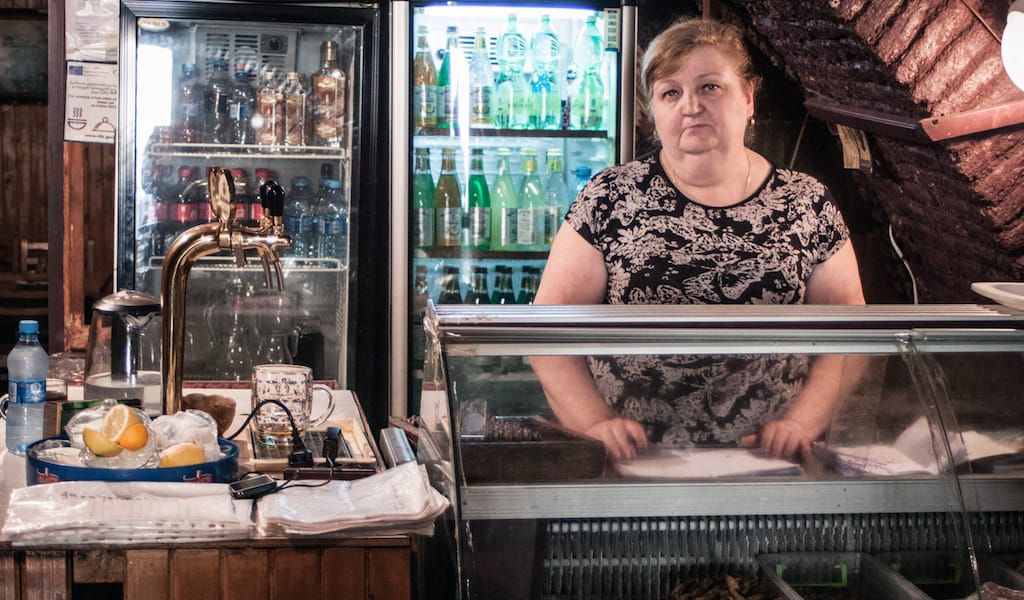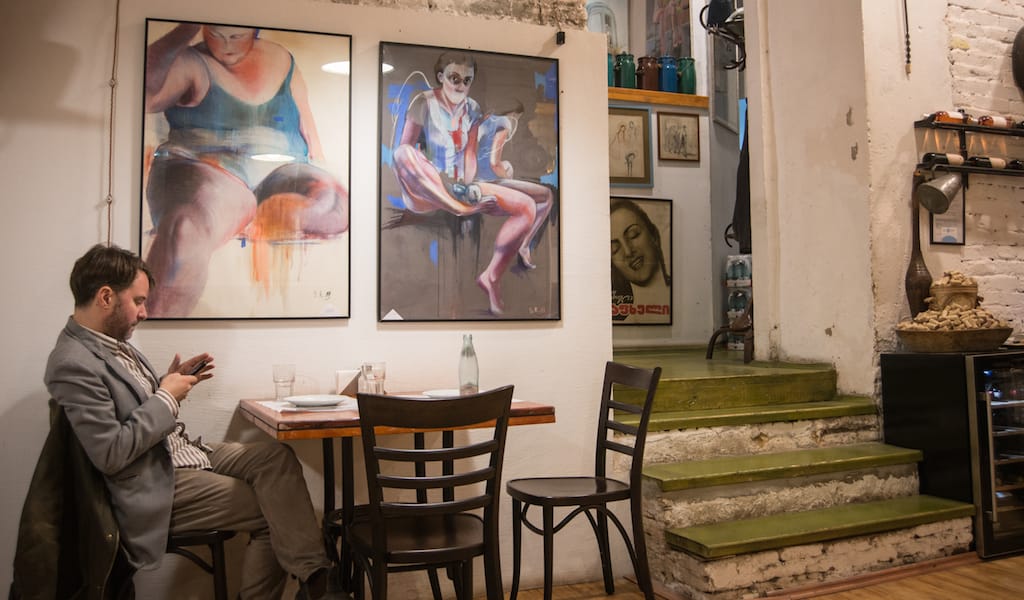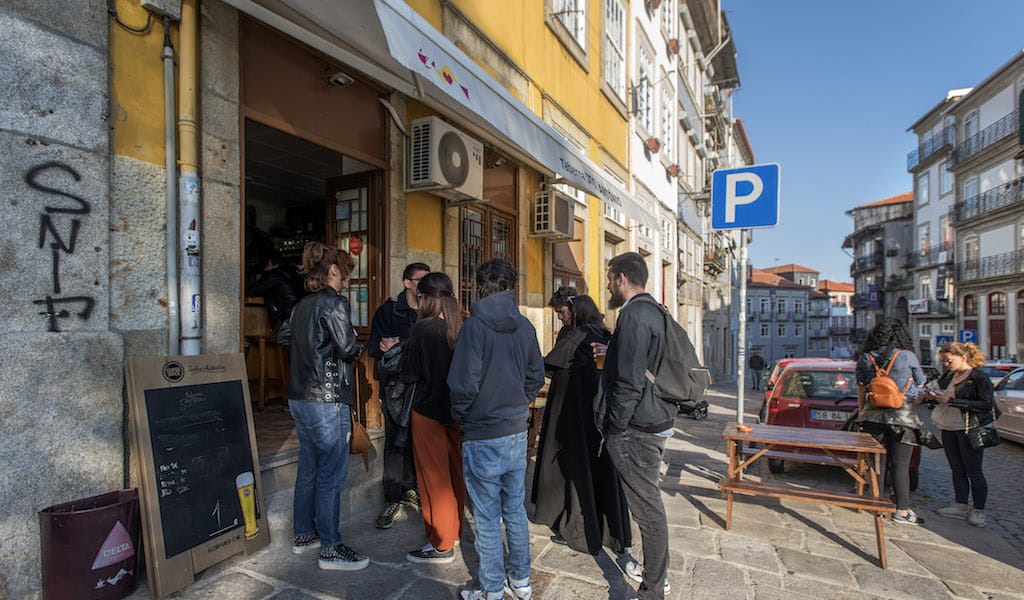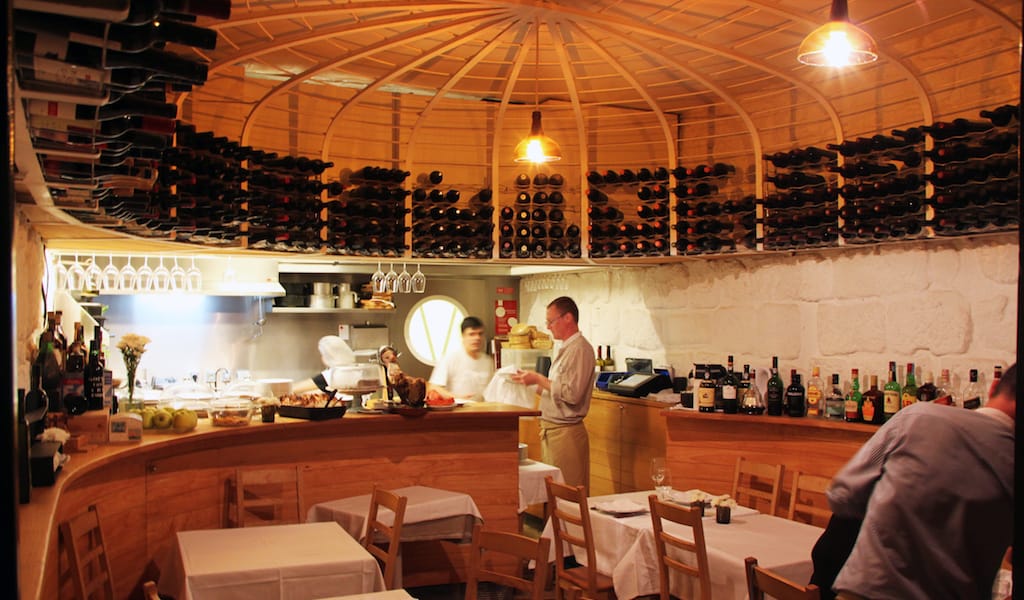We returned to Tbilisi in 2002 with the intention of staying one year. On that first day back, our friends took us to a chummy brick-walled cellar in Sololaki. There was enough sunlight coming down through the door to illume low pine tables and seating for fifty people max. In a refrigerated counter, menu items were displayed: beef tongue, tomato and cucumber salad, assorted cheeses, badrijani (sliced fried eggplant stuffed with a garlicky walnut paste), all the standard stuff.
It was a Georgian greasy spoon, for sure, with a kitchen that would make a health inspector shudder, but the khinkali were really good, and the house wine was as decent as it comes. The name of the place was Dukani Racha. Little did we know people had been coming here for decades.
As our first year stretched into two, then a dozen and more, the neighborhood’s culinary life expanded as restaurants popped up offering new savory experiences to Tbilisi’s residents. Some of these places became local dining fixtures while others had brief lives, only to be replaced by other eateries that would share the same ill fate. But as time passed, Dukani Racha’s door remained open, with its humble hand-painted sign hanging above. It is one place impervious to change.

Racha is a region snuggled in the high Caucasus between Svaneti, Imereti, Shida Kartli and the Russian border. It is known for many specialty dishes like cured smoked pork and shkmeruli, baked chicken buried under a profane heap of garlic. However, you won’t find either of these characteristic regional delicacies at the namesake restaurant right now because it is Lent.
“We have beans and cornbread!” the boss Manana retorted when we asked for Rachan fare on a recent visit. It had been years since we were last there – one of those things that just happens in this city of plenty – and the whole fasting thing had slipped our minds. Manana, the surly blonde “director,” is clearly in charge from her helm behind the display fridge. Her crew of waitresses have no reasons to smile. This is Georgian old school where the customers are never right – they are only fed.
Dukani Racha is one place impervious to change.
At a side table there is the inevitable group of middle-aged men hunched over their meals, straightening up to make a toast or to light a cigarette. In the corner, two cooks are smoking and drinking coffee at their table by the kitchen entrance. Our waitress plops our simple salad of sliced tomatoes, cucumbers and onion on our table along with a basket of bread. There is something sympathetic about the grumpiness here. It’s almost as if any of the staff smiled, they would jinx the food.
The next dish plunked on the table was a little ceramic pot of beans. The standard Georgian lobio recipe calls for blue fenugreek, garlic and coriander, both dried and fresh. It’s that fresh herby zest that makes all the difference. Up in Racha they add chunks of smoked pork, which this kitchen will toss in after Easter. Still, these beans are slow-cooked to creamy perfection and go excellently with mchadi, Georgian cornbread.

Some meat dishes have been left on the menu for the ungodly, like their specialty, abkhazura, an intensely rich cutlet from the Black Sea region of Abkhazia. Patties of spiced minced pork and beef with pomegranate seeds are wrapped in caul fat and then often roasted in a ceramic casserole dish called a ketsi. Here they are fried and served on a bed of perfectly French-fried potatoes in a scorching metal pan and topped with caramelized onions. The fries soak up all the tangy, garlic-infused drippings.
The chicken mtsvadi was also a winner. These skewered nuggets of white meat basted in tomato sauce were tender and succulent. We sopped our plates clean with bread and washed it all down with Rkatsiteli, the house Kakhetian white.
Throughout the meal, we had been plying Manana with questions, which she answered with succinct civility. She explained that this spot had been a dukani – a tavern – for 100 years. “Tbilisi’s oldest,” she asserted. It became Racha thirty years ago when Jambol Kobakhidze from Nikortsminda bought the spot. She arrived fifteen years later.
“Well, the food is very delicious!” we declared. Upon hearing that, Manana granted us a Mona Lisa smile.
This article was originally published on March 26, 2018.
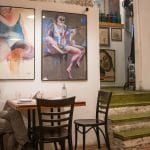 July 5, 2021 Salobie Bia
July 5, 2021 Salobie Bia
This story starts with a hamburger, a juicy, perfectly grilled patty between a pair of […] Posted in Tbilisi June 21, 2021 Taberna Santo António
June 21, 2021 Taberna Santo António
We arrived at Taberna Santo António after lunch, looking for a bit of warmth in the […] Posted in Porto June 29, 2019 Taberna dos Mercadores
June 29, 2019 Taberna dos Mercadores
Seating around only 20 people, Taberna dos Mercadores is a microcosmic reflection of […] Posted in Porto
Published on June 16, 2022
Related stories
July 5, 2021
TbilisiThis story starts with a hamburger, a juicy, perfectly grilled patty between a pair of fresh, no-frill homemade buns and the standard trimmings. As burgers become part of the culinary landscape in Tbilisi, we find that many cooks have a tendency to get too slick with a dish that loathes pretension. But this place, Burger…
June 21, 2021
Porto | By Cláudia Brandão
PortoWe arrived at Taberna Santo António after lunch, looking for a bit of warmth in the middle of winter. It wasn’t a shot in the dark – we already knew that we would be enveloped by a comforting hospitality at this classic Porto spot. The sun was shining, so we sat on the terrace with…
June 29, 2019
PortoSeating around only 20 people, Taberna dos Mercadores is a microcosmic reflection of contemporary Porto: a mixture of high-concept design and traditional food. From a design perspective, the focal point of the small yet comfortable dining room is the ceiling, where white metal supports create the outline of a false dome. Although sculptural in nature,…







































